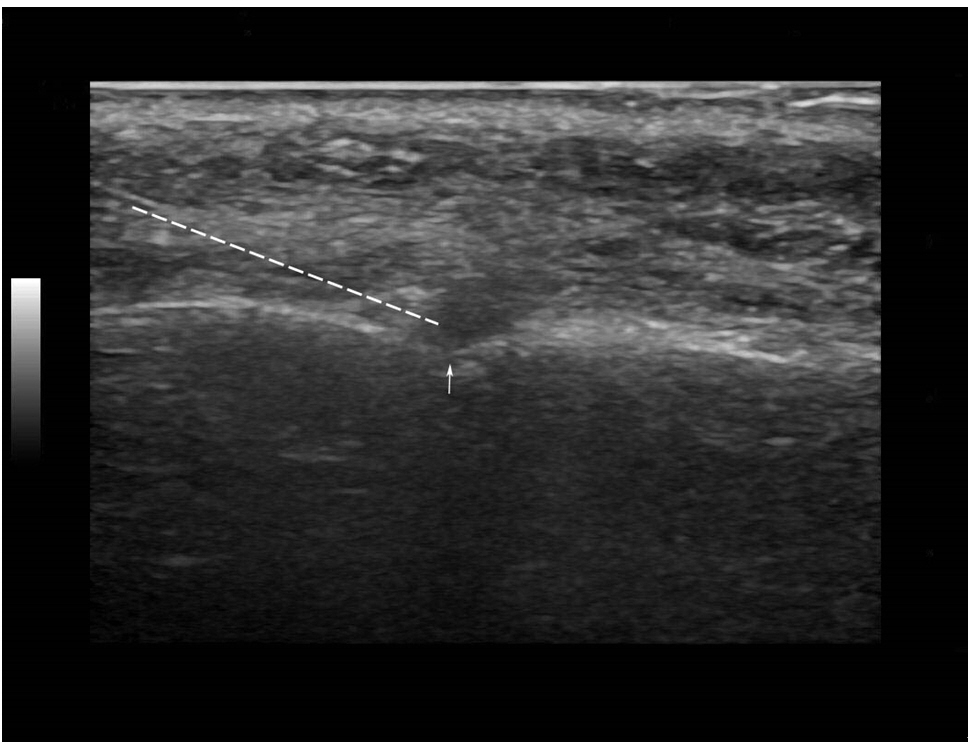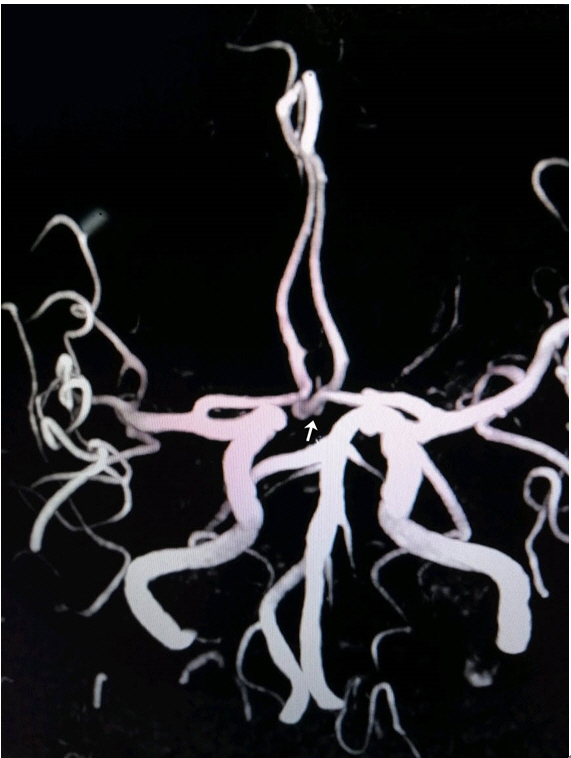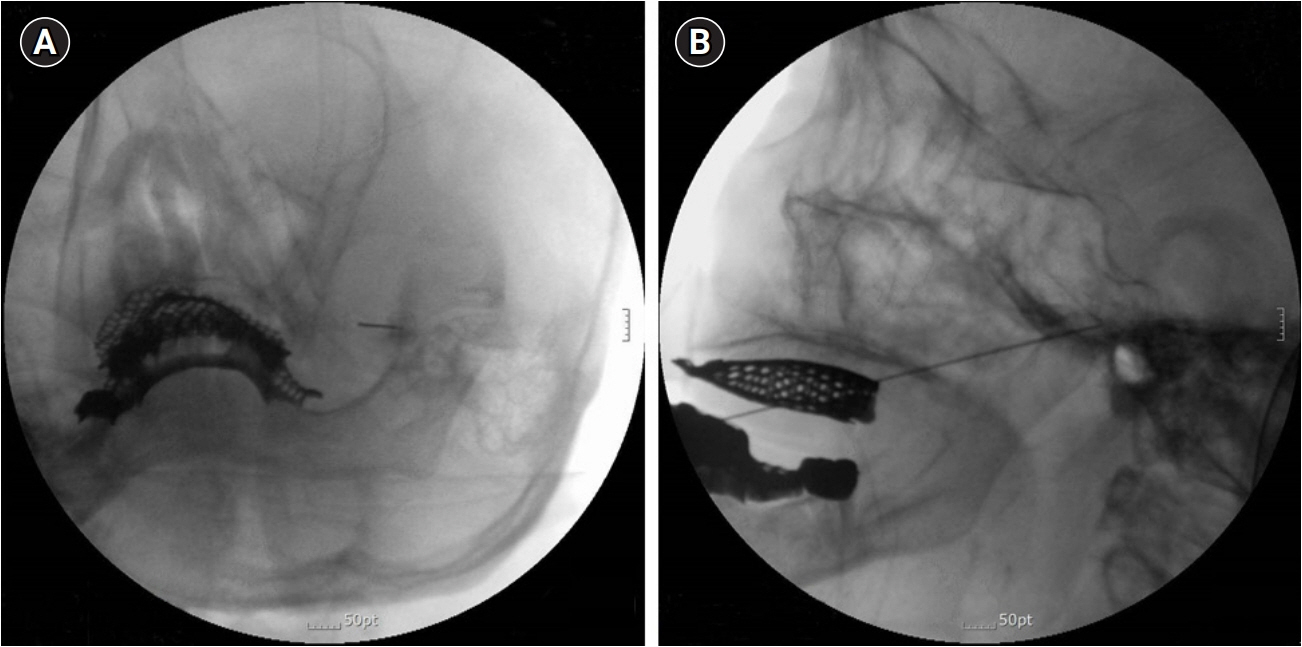Anesth Pain Med.
2021 Oct;16(4):382-386. 10.17085/apm.21019.
Gasserian ganglion radiofrequency thermoablation in a patient with aneurysm of the anterior communicating artery -A case report-
- Affiliations
-
- 1Department of Anesthesiology and Pain Medicine, Keimyung University Dongsan Hospital, Daegu, Korea
- KMID: 2524451
- DOI: http://doi.org/10.17085/apm.21019
Abstract
- Background
Gasserian ganglion radiofreqeucy thermoablation is a good treatment option for the management of pain in trigeminal neuralgia. We report a case in which the patient of trigeminal neuralgia combined with anterior cerebral artery aneurysm was treated successfully by gasserian ganglion thermoablation without any complication. Case An 85-year-old female presenting with electric shock like sensation in the gum and molar teeth was diagnosed as trigeminal neuralgia. Carbamazepine medication and trigeminal nerve blockade relieved her pain partially, but severe side effects of carbamazepine occurred. Magnetic resonance angiography of the brain showed saccular aneurysm in inferior aspect of the anterior communicating artery. Gasserian ganglion thermoablation under sedation anesthesia using nicardipine was performed carefully without any rupture of the cerebral aneurysm.
Conclusions
Gasserian ganglion thermoablation could be performed safely in a patient with cerebral aneurysm without any inadvertent event.
Keyword
Figure
Reference
-
1. De Toledo IP, Conti Réus J, Fernandes M, Porporatti AL, Peres MA, Takaschima A, et al. Prevalence of trigeminal neuralgia: a systematic review. J Am Dent Assoc. 2016; 147:570–6.e2.2. Huibin Q, Jianxing L, Guangyu H, Dianen F. The treatment of first division idiopathic trigeminal neuralgia with radiofrequency thermocoagulation of the peripheral branches compared to conventional radiofrequency. J Clin Neurosci. 2009; 16:1425–9.3. Tölle T, Dukes E, Sadosky A. Patient burden of trigeminal neuralgia: results from a cross-sectional survey of health state impairment and treatment patterns in six European countries. Pain Pract. 2006; 6:153–60.4. Al-Quliti KW. Update on neuropathic pain treatment for trigeminal neuralgia. The pharmacological and surgical options. Neurosciences (Riyadh). 2015; 20:107–14.5. Kanpolat Y, Savas A, Bekar A, Berk C. Percutaneous controlled radiofrequency trigeminal rhizotomy for the treatment of idiopathic trigeminal neuralgia: 25-year experience with 1,600 patients. Neurosurgery. 2001; 48:524–32; discussion 532-4.6. Bozkurt M, Al-Beyati ES, Ozdemir M, Kahilogullari G, Elhan AH, Savas A, et al. Management of bilateral trigeminal neuralgia with trigeminal radiofrequency rhizotomy: a treatment strategy for the life-long disease. Acta Neurochir (Wien). 2012; 154:785–91; discussion 791-2.7. Love S, Coakham HB. Trigeminal neuralgia: pathology and pathogenesis. Brain. 2001; 124(Pt 12):2347–60.8. Zhang XJ, Gao BL, Hao WL, Wu SS, Zhang DH. Presence of anterior communicating artery aneurysm is associated with age, bifurcation angle, and vessel diameter. Stroke. 2018; 49:341–7.9. Meng Q, Zhang W, Yang Y, Zhou M, Li X. Cardiovascular responses during percutaneous radiofrequency thermocoagulation therapy in primary trigeminal neuralgia. J Neurosurg Anesthesiol. 2008; 20:131–5.10. Cha ST, Eby JB, Katzen JT, Shahinian HK. Trigeminocardiac reflex: a unique case of recurrent asystole during bilateral trigeminal sensory root rhizotomy. J Craniomaxillofac Surg. 2002; 30:108–11.11. Wallin JD, Cook ME, Blanski L, Bienvenu GS, Clifton GG, Langford H, et al. Intravenous nicardipine for the treatment of severe hypertension. Am J Med. 1988; 85:331–8.12. Qin Q, Wang Y. Recurrent trigeminocardiac reflex in percutaneous balloon compression for trigeminal neuralgia: a case report. Medicine (Baltimore). 2020; 99:e22467.13. Dzierżanowski J, Słoniewski P. Trigeminal neuralgia caused by aneurysm of the posterior cerebral artery: a case description and the analysis of anatomical variety of vascular complex in the root entry zone of trigeminal nerve. Folia Morphol (Warsz). 2014; 73:224–8.14. Simonet C, Arrese I, Sarabia R. Giant posterior communicating artery aneurysm presenting as trigeminal neuralgia. J Stroke Cerebrovasc Dis. 2016; 25:2243–6.15. Lopez BC, Hamlyn PJ, Zakrzewska JM. Systematic review of ablative neurosurgical techniques for the treatment of trigeminal neuralgia. Neurosurgery. 2004; 54:973–82; discussion 982-3.16. Zheng S, Li X, Li R, Yang L, He L, Cao G, et al. Factors associated with long-term risk of recurrence after percutaneous radiofrequency thermocoagulation of the gasserian ganglion for patients with trigeminal neuralgia: a multicenter retrospective analysis. Clin J Pain. 2019; 35:958–66.17. Zheng JH, Sun K, Zhang HT, Xie YJ, Wang-Yang LX, Chen HY, et al. A study on the recurrence rate of trigeminal neuralgia after MVD and the related factors. J Neurol Surg B Skull Base. 2020; 81:572–8.
- Full Text Links
- Actions
-
Cited
- CITED
-
- Close
- Share
- Similar articles
-
- Microsurgical anatomy of the Anterior Cerebral-anterior Communicating Artery
- Transposition of Anterior Choroidal Artery and Posterior Communicating Artery Origin
- Percutaneous Streotaxic Gasserian Ganglionotomy with Radiofrequency Current in Trigeminal Neuralgia
- Anterior Communicating Artery Aneurysms Associated with Multiplication of Anterior Communicating Artery
- Radiofrequency Thermocoagulation of the Gasserian Ganglion




